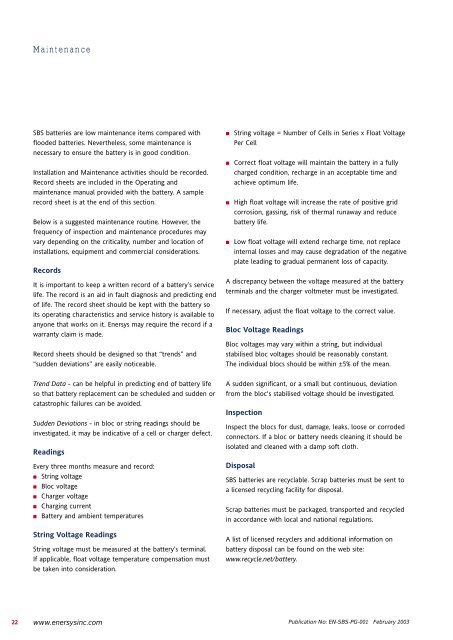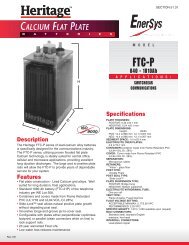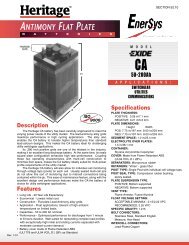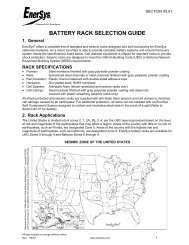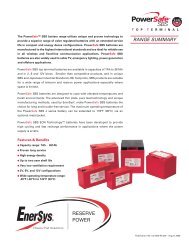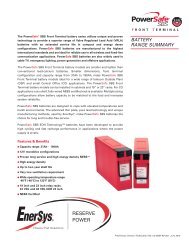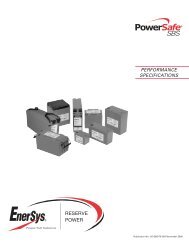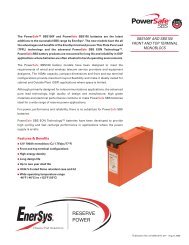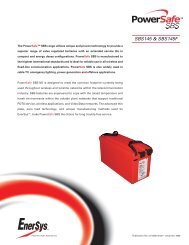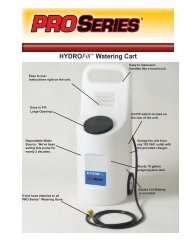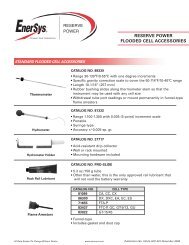PowerSafe V Product Guide new - EnerSys
PowerSafe V Product Guide new - EnerSys
PowerSafe V Product Guide new - EnerSys
Create successful ePaper yourself
Turn your PDF publications into a flip-book with our unique Google optimized e-Paper software.
22<br />
Maintenance<br />
SBS batteries are low maintenance items compared with<br />
flooded batteries. Nevertheless, some maintenance is<br />
necessary to ensure the battery is in good condition.<br />
Installation and Maintenance activities should be recorded.<br />
Record sheets are included in the Operating and<br />
maintenance manual provided with the battery. A sample<br />
record sheet is at the end of this section.<br />
Below is a suggested maintenance routine. However, the<br />
frequency of inspection and maintenance procedures may<br />
vary depending on the criticality, number and location of<br />
installations, equipment and commercial considerations.<br />
Records<br />
It is important to keep a written record of a battery’s service<br />
life. The record is an aid in fault diagnosis and predicting end<br />
of life. The record sheet should be kept with the battery so<br />
its operating characteristics and service history is available to<br />
anyone that works on it. Enersys may require the record if a<br />
warranty claim is made.<br />
Record sheets should be designed so that “trends” and<br />
“sudden deviations” are easily noticeable.<br />
Trend Data - can be helpful in predicting end of battery life<br />
so that battery replacement can be scheduled and sudden or<br />
catastrophic failures can be avoided.<br />
Sudden Deviations - in bloc or string readings should be<br />
investigated, it may be indicative of a cell or charger defect.<br />
Readings<br />
Every three months measure and record:<br />
■ String voltage<br />
■ Bloc voltage<br />
■ Charger voltage<br />
■ Charging current<br />
■ Battery and ambient temperatures<br />
String Voltage Readings<br />
String voltage must be measured at the battery’s terminal.<br />
If applicable, float voltage temperature compensation must<br />
be taken into consideration.<br />
www.enersysinc.com<br />
■ String voltage = Number of Cells in Series x Float Voltage<br />
Per Cell<br />
■ Correct float voltage will maintain the battery in a fully<br />
charged condition, recharge in an acceptable time and<br />
achieve optimum life.<br />
■ High float voltage will increase the rate of positive grid<br />
corrosion, gassing, risk of thermal runaway and reduce<br />
battery life.<br />
■ Low float voltage will extend recharge time, not replace<br />
internal losses and may cause degradation of the negative<br />
plate leading to gradual permanent loss of capacity.<br />
A discrepancy between the voltage measured at the battery<br />
terminals and the charger voltmeter must be investigated.<br />
If necessary, adjust the float voltage to the correct value.<br />
Bloc Voltage Readings<br />
Bloc voltages may vary within a string, but individual<br />
stabilised bloc voltages should be reasonably constant.<br />
The individual blocs should be within ±5% of the mean.<br />
A sudden significant, or a small but continuous, deviation<br />
from the bloc's stabilised voltage should be investigated.<br />
Inspection<br />
Inspect the blocs for dust, damage, leaks, loose or corroded<br />
connectors. If a bloc or battery needs cleaning it should be<br />
isolated and cleaned with a damp soft cloth.<br />
Disposal<br />
SBS batteries are recyclable. Scrap batteries must be sent to<br />
a licensed recycling facility for disposal.<br />
Scrap batteries must be packaged, transported and recycled<br />
in accordance with local and national regulations.<br />
A list of licensed recyclers and additional information on<br />
battery disposal can be found on the web site:<br />
www.recycle.net/battery.<br />
Publication No: EN-SBS-PG-001 February 2003


